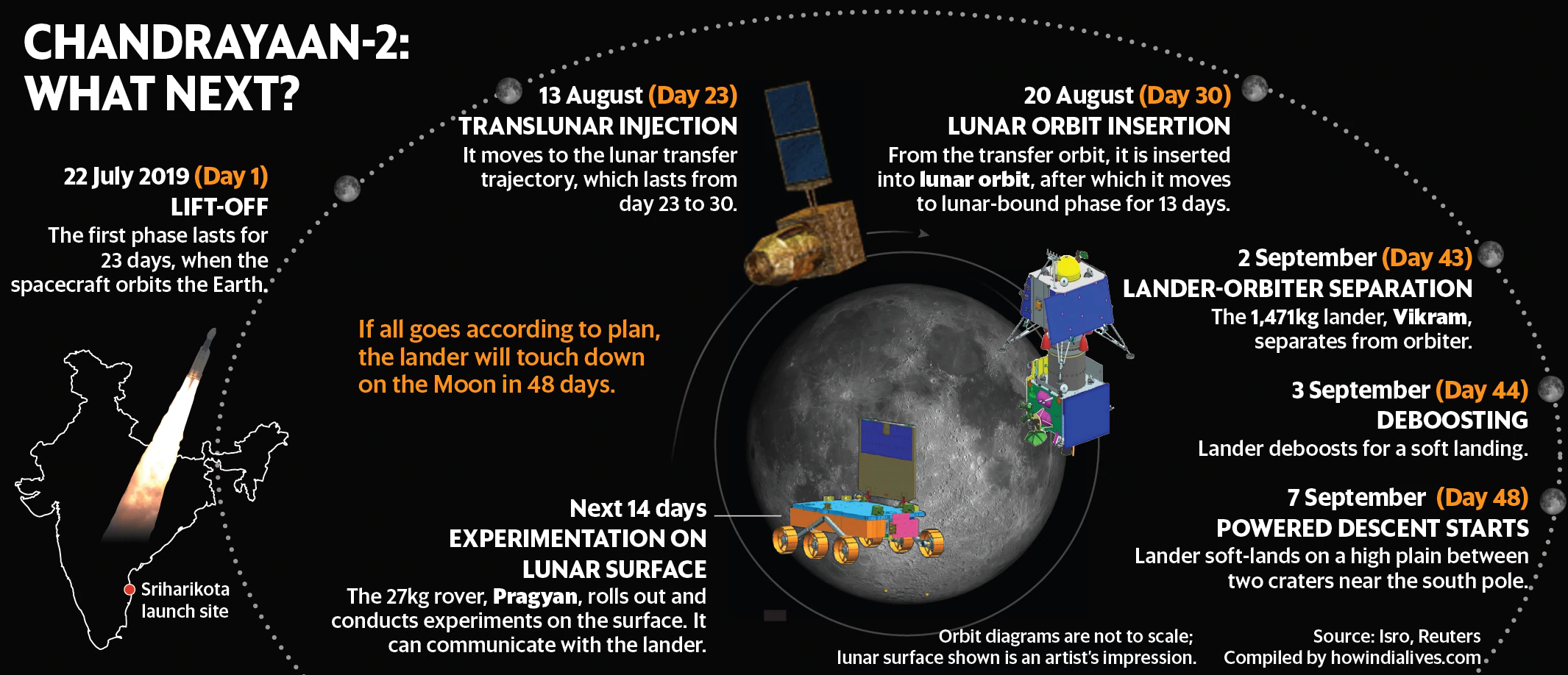Chandrayaan-2 Debriefed
Chandrayaan 2
Chandrayaan 2 mission launched from the Satish Dhawan Space Center on India’s southeast coast. The mission consists of an orbiter; a lander named Vikram after Indian space scientist Vikram Sarabhai; and a rover named Pragyan, the Sanskrit word for wisdom.
The lander and rover are expected to touch down at a site between two craters on September 7. After landing, the Pragyan rover will separate from the lander and drive up to 500 meters across the landscape. The rover carries a pair of spectrometers to measure the elemental composition of the lunar soil. The rover and lander will last about one lunar day, or 14 Earth days, and will run out of power during the lunar night. The orbiter will continue to observe the moon for a year.
The south pole of Moon
The targeted landing site is at about 70° S latitude, putting India's lander closer to the moon’s south pole than any previous landers. China’s Chang’e-4 spacecraft, which landed in a large impact basin on the far side of the moon in January, sits at about 45.5° S latitude. The south pole is interesting to scientists not just because it hasn’t been studied much before, but also because lunar orbiters — including India’s first lunar visitor, Chandrayaan 1 — have seen evidence for water molecules in the soil there. There could also be water ice hidden in permanently shadowed craters near the south pole
Cryogenic technology
ISRO’s GSLV Mark III is a three-stage rocket with first and second stages filled with solid and liquid propellants, respectively. The third stage is the cryogenic stage. A cryogenic system is sought after since it provides more thrust per kilogram of propellants. The cryogenic engine uses liquid oxygen (LOX) and liquid hydrogen (LH2) as propellants. Chandrayaan-2 is only the first operational flight of GSLV Mark III with indigem=nious cryogenic technology
What Chandrayaan 2 is about?
Chandrayaan-2 is actually three satellite missions stacked in a single launch vehicle mission. Out of the three, two systems are totally new to us — Vikram lander and rover Pragyan. The Chandrayaan-2 team will now perform 15 very crucial manoeuvres in the coming one-and-half months to take Chandrayaan-2 towards Moon. After the 15-minute terrifying moment during the final descent, the lander will land safely on Moon
Critical Soft landing manoeuvre
Chandrayaan-2 will remain in Earth's elliptical orbit for around 22 days when five orbit-raising manoeuvres will be conducted to move it away from Earth's gravitational pull. Thereafter, the lunar craft will be moved into trans lunar injection (TLI) on the 23rd day for its onward journey to the lunar orbit during which it will travel a distance of 3,84,000km from Earth to Moon. After eight days, the Chandrayaan-2 team will oversee the lunar orbit insertion, the next most challenging part of the country's second moon mission. This part of the mission deals with slowing the speed of the lunarcraft so that it gets captured by Moon's gravity to help it enter the lunar orbit.
43rd day after the launch, lander 'Vikram' housing rover 'Pragyan' will get separated from the orbiter. Vikram needs to go around Moon in a 30km x 100km orbit before initiating deboosting procedures on Day 44. On the 48th day, the final descent of Vikram will start and it will attempt landing on Moon. On landing, Pragyan will come out of Vikram after four hours. It will roll out at a speed of 1cm per second. During its lifespan of one lunar day (14 Earth days), Pragyan will move up to 500 metres on Moon. It will take images and analyse content on the lunar surface and send back data via Vikram or the orbiter to Earth within 15 minutes.
While Vikram and Pragyan will last for a lunar day, the orbiter will continue to circle around Moon for over a year during which it will also map Moon and take images of different areas to look for water and "new science". A passive payload of Nasa, Laser Retroreflector Array, attached to Vikram will calculate the distance between the Earth and Moon and help detect the exact location of the lander on Moon.
Chandrayaan-2 is loaded with 13 payloads that will do a detailed study of topography, seismography, mineral identification and distribution, surface chemical composition, thermo-physical characteristics of topsoil and composition of the tenuous lunar atmosphere for a new understanding of the origin and evolution of Moon.


 IAS -2025 Prelims Combined Mains Batch - III Starts - 14-04-2024
IAS -2025 Prelims Combined Mains Batch - III Starts - 14-04-2024